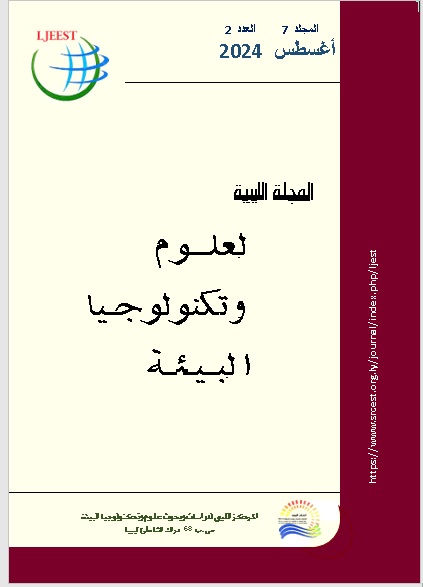الصفات المورفولوجية للبلوط القرمزيQuercus coccifera على ارتفاعات مختلفة من سطح البحر بمنطقة الجبل الأخضر- شرق ليبيا
DOI:
https://doi.org/10.63359/dr5ne118الكلمات المفتاحية:
البلوط القرمزي، مورفولوجي، الارتفاعات، الجبل الاخضر ، ليبياالملخص
تعكس الصفات المورفولوجية تكيف الأشجار مع بيئتها، وتوفر فهماً للتفاعلات بين الأشجار والبيئة، وتقيّيم آثار التغيرات البيئية على الأنواع النباتية لها دور أساسي ومهم في دراسة التنوع البيولوجي للأشجار لأنها توفر معلومات عن تقييم الأنواع وتأثرها بالظروف البيئية. تم تقييم الصفات المورفولوجية لأشجار البلوط القرمزي Quercus coccifera L. خلال موسم 2022 في ثلاثة مواقع مختلفة في الارتفاع عن سطح البحر بمنطقة الجبل الأخضر، شرق ليبيا. أشارت النتائج إلى وجود فروق معنوية في ارتفاع وأقطار الأشجار بين المواقع، حيث تميزت الأشجار بأقل ارتفاع للأشجار وأصغر قطر لها، بينما كانت أعلى ارتفاع وأكبر قطر للأشجار على ارتفاع (493م). وتميزت الأشجار في الموقع (333م) بأطول وأعرض ورقة وأقصر أعناق الأوراق، بينما تميزت الشجرة في الموقع (493م) بأقصر ورقة وأصغر عرض ورقة. من ناحية أخرى، لم تكن هناك فروق ذات دلالة إحصائية في طول النورات المذكرة والمؤنثة، وعدد الأزهار في النورة الواحدة، وصفات البلوط بين الأشجار في المواقع الثلاثة. من المهم الاهتمام بهذا النوع المحلي والمحافظة عليه وتنميته وضمان بقائه وتجدده في منطقة الجبل الأخضر.
المراجع
Albarrán-Lara, A. L., Petit, R. J., Kremer, A., Caron, H., Peñaloza-Ramírez, J. M., Gugger, P. F & Oyama, K. (2019). Low genetic differentiation between two morphologically and ecologically distinct giant-leaved Mexican oaks. Plant Systematics and Evolution, 305, 89-101. 10.1007/s00606-018-1554-8
Aravanopoulos, F.A. (2004). Phenotypic variation and population relationships of chestnut (Castanea sativa) in Greece, revealed by multivariate analysis of leaf morphometrics. In III International Chestnut Congress, 693,233-240. 10.17660/ActaHortic.2005.693.28
Balaguer, L., Martínez-Ferri, E., Valladares, F., Pérez-Corona, M. E., Baquedano, F. J., Castillo, F.J. & Manrique, E. (2001). Population divergence in the plasticity of the response of Quercus coccifera L. to the light environment. Functional ecology, 124-135. 10.1046/j.1365-2435.2001.00505.x
Booth,M.S., Stark,J.M & Rastetter,E. (2005). Controls on nitrogen cycling in terrestrial ecosystems: a synthetic analysis of literature data. Ecological monographs, 75(2), 139-157. 10.1890/04-0988
Bruschi, P., Vendramin,G.G., Bussotti, F & Grossoni, P. (2003). Morphological and molecular diversity among Italian populations of Quercus petraea (Fagaceae). Annals of Botany, 91(6), 707-716. 10.1093/aob/mcg075
Canellas, I & San-Miguel, A. (2000). Biomass of root and shoot systems of Quercus coccifera shrublands in Eastern Spain [root: shoot ratio]. Annals of Forest Science (France), 57(8). 10.1051/forest:2000160
Ellsworth, D.S. & Reich, P.B. (1993). Canopy structure and vertical patterns of photosynthesis and related leaf traits in a deciduous forest. Oecologia, 96, 169-178. 10.1007/BF00317729
Gea-Izquirdo, G., Canellas, I. & Montero, G. (2006). Acorn production in Spanish holm oak woodlands. Investigacion Agraria: Sistemasy Recursos Forestales 15(3), 339-354. 10.5424/srf/2006153-00976
González-Rodríguez, A & Oyama, K. E. N. (2005). Leaf morphometric variation in Quercus affinis and Quercus laurina (Fagaceae), two hybridizing Mexican red oaks. Botanical Journal of the Linnean society, 147(4),427-435.10.1111/j.1095-8339.2004.00394.x
Gouveia,A.C. & Freitas,H.(2009). Modulation of leaf attributes and water use efficiency in Quercus suber L. along a rainfall gradient. Trees, 23, 267-275.
Kremer,A., Dupouey,J.L., Deans,J.D., Cottrell,J., Csaikl,U., Finkeldey,R. & Badeau,V. (2002). Leaf morphological differentiation between Quercus robur and Quercus petraea is stable across western European mixed oak stands. Annals of Forest Science, 59(7), 777-787. 10.1007/s00468-008-0274-z
Leigh,A., Sevanto,S., Ball,M.C., Close,J.D., Ellsworth,D.S., Knight,C.A. & Vogel, S. (2012). Do thick leaves avoid thermal damage in critically low wind speeds? New Phytologist, 194(2), 477-487. 10.1111/j.1469-8137.2012.04058.x
Lin,S., Shao,L., Hui,C., Sandhu,H.S., Fan,T., Zhang, L. & Shi, P. (2018). The effect of temperature on the developmental rates of seedling emergence and leaf-unfolding in two dwarf bamboo species. Trees, 32, 751-763. 10.1007/s00468-018-1669-0
Liu,W., Zheng,L. & Qi,D. (2020). Variation in leaf traits at different altitudes reflects the adaptive strategy of plants to environmental changes. Ecology and Evolution, 10(15), 8166-8175. 10.1002/ece3.6519
Maya-García, R., Torres-Miranda, A., Cuevas-Reyes, P. & Oyama, K. (2020). Morphological differentiation among populations of Quercus elliptica Neé. (Fagaceae) along an environmental gradient in Mexico and Central America. Botanical Sciences, 98(1), 50-66.10.17129/botsci.2395
McDonald, PG, Fonseca. C.R, Overton. J.M, Westoby. M. (2003). Leaf size divergence along rainfall and soil- nutrient gradients: is the method of size reduction common among clades? Funct Ecol, 17(1): 50- 57. 10.1046/j.1365-2435.2003.00698.x
McLean,E.H., Prober,S.M., Stock,W. D., Steane, D. A., Potts, B. M., Vaillancourt, R.E. & Byrne, M. (2014). Plasticity of functional traits varies clinally along a rainfall gradient in Eucalyptus tricarpa. Plant, cell & environment, 37(6), 1440-1451. 10.1111/pce.12251
Mitchell, K.A., Bolstad, P.V. & Vose, J. M. (1999). Interspecific and environmentally induced variation in foliar dark respiration among eighteen southeastern deciduous tree species. Tree physiology, 19(13), 861-870. 10.1093/treephys/19.13.861
Neophytou,C.H., Palli,G., Dounavi,A. & Aravanopoulos,F.A.(2007). Morphological differentiation and hybridization between Quercus alnifolia Poech and Quercus coccifera L.(Fagaceae) in Cyprus. SilvaeGenetica, 56(1-6), 271-277.10.1515/sg-2007-0038
Ordoñez,J. C., Van Bodegom,P.M., Witte,J. P. M., Wright, I. J., Reich, P.B. &Aerts, R. (2009). A global study of relationships between leaf traits, climate and soil measures of nutrient fertility. Global Ecology and Biogeography, 18(2), 137-149. 10.1111/j.1466-8238.2008.00441.x
Papatheodorou, E. M., Pantis, J. D. & Stamou, G. P. (1998). The effect of grazing on phenology and biomass allocation in Quercus coccifera (L.). Acta Oecologica, 19(4), 339-347.10.1016/s1146-609x(98)80038-6
Perez-Luque,A.J., Gea-Izquierdo,G. & Zamora,R.(2021).Land-use leacies and climate change as a double challenge to Oak forest resilience: mismatches of geographical and ecological rear edges. Ecosystems, (24),755-773. 10.1007/s10021-020-00547-y
Ramírez-Valiente, J.A; Kari. K; Cavender-Bares.J.(2015). Climatic origins predict variation in photoprotective leaf pigments in response to drought and low temperatures in live oaks (Quercus series Virentes). Tree Physiology, 35(5), :521–534. 10.1093/treephys/tpv032
Rodríguez-Gómez, F., Oyama,K., Ochoa-Orozco,M., Mendoza-Cuenca, L., Gaytán-Legaria, R. & González-Rodríguez, A. (2018). Phylogeography and climate-associated morphological variation in the endemic white oak Quercus deserticola (Fagaceae) along the Trans-Mexican Volcanic Belt. Botany, 96(2), 121-133. 10.1139/cjb-2017-0116
Rodríguez-Rivera,I.S. & Romero-Rangel,S.(2007). Arquitectura foliar de diezespecies de encino (Quercus, Fagaceae) de México. Acta botánicamexicana, (81), 09-34. 10.21829/abm81.2007.1049
Sisó,S ., Camarero, J. & Gil-Pelegrín,E. (2001). Relationship between hydraulic resistance and leaf morphology in broad leaf Quercus species: a new interpretation of leaf lobation. Trees, 15, 341-345. 10.1007/s004680100110
Souad, El. M. & Amraoui, M.B. (2020). Effect of soil properties on growth of Quercus ilex L. in humid and cold mountains of Morocco. Applied and Environmental Soil Science, 1-9. 10.1155/2020/8869975
Study and evaluation natural vegetation in Al- jabal Al- Akhdar area.2005. (In Arabic), Al Bieda, Omer Almukhtar Universty.
Tang, C. Q. & Ohsawa.M. (1999). Altitudinal distribution of evergreen broad- leaved trees and their leaf-size pattern on a humid subtropical mountain, Mt. Emei, Sichuan, China. Plant Ecology, 145, 221-233. 10.1023/A:1009856020744
Uribe-Salas, D., Sáenz-Romero, C., González-Rodríguez, A., Téllez-Valdéz,O. & Oyama, K. (2008). Foliar morphological variation in the white oak Quercus rugosa Née (Fagaceae) along a latitudinal gradient in Mexico: Potential implications for management and conservation. Forest Ecology and Management, 256(12), 2121-2126. 10.1016/J.FORECO.2008.08.002
Valencia, A.S. (2004). Diversidad del género Quercus (Fagaceae) en México. Botanical sciences, (75), 33- 53. 10.17129/botsci.1692
Valladares, F., Matesanz. S., Guilhaumon. F., Araújo. M. B., Balaguer. L., Benito‐Garzón. M & Zavala. M. A. (2014). The effects of phenotypic plasticity and local adaptation on forecasts of species range shifts under climate change. Ecology letters, 17(11), 1351- 1364 . 10.1111/ele.12348
Velazquez-Rosas, N., Meave, J.A., Santana, S.V. (2002). Elevational variation of Leaf traits in montane rain forest tree species at la Chainantla, Southern Mexico. Biotropica, (4)34:534-546.
Xu, F., Guo, W., Xu, W., Wei, Y & Wang, R. (2009). Leaf morphology correlates with water and light availability: what consequences for simple and compound leaves? Progress in Natural Science, 19(12), 1789-1798. 10.1016/j.pnsc.2009.10.001
Zunni, S. A. and Bayoumi, A. M. (2006). Important local and exotic trees and shrubs in Jabal elAkhdar, Libya (In Arabic). Aldar Academy for printing, authoring, translation and publishing. Tripoli, Libya.270pp.
التنزيلات
منشور
إصدار
القسم
الرخصة
الحقوق الفكرية (c) 2025 المجلة الليبية لعلوم وتكنولوجيا البيئة (م ل ع ت ب)

هذا العمل مرخص بموجب Creative Commons Attribution-NonCommercial 4.0 International License.















